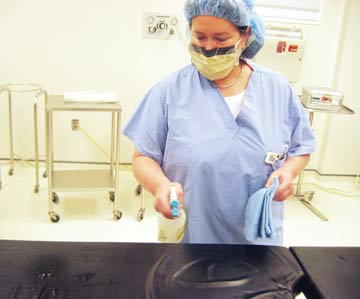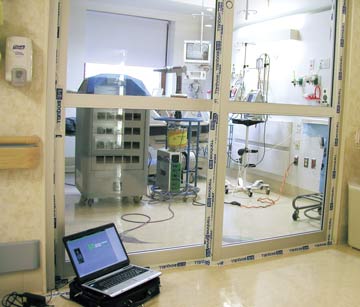It helps to categorize whole-room disinfection technologies by their time-dependent mode of operation: Is it episodic or continuous?
Episodic disinfection includes mobile ultraviolet-C (UV-C) devices, hydrogen peroxide vapor (HPV) or mist systems, and ozone systems that provide disinfection within a discrete period of time in an unoccupied space because of safety concerns. You can deploy these devices at the end of the day or between cases, with varying "run" times.
- Mobile UV-C systems. There are 2 classes of mobile ultraviolet light systems: those with steady-state, low-pressure mercury bulbs that emit light at the 254nm wavelength, and those with xenon bulbs that emit short, high-intensity pulsed light encompassing the UV (100nm to 280nm) and visible (380nm to 700nm) range, the former requiring a slightly longer "run" time than the latter. Under optimal conditions, mobile UV-C systems provide highly effective surface decontamination. UV-C irradiation is potent against a broad range of bacteria, viruses and fungi, including multidrug-resistant organisms. Research has repeatedly shown an association between their use and significant reductions in surface contamination as well as healthcare-associated infections.
A few disadvantages to mobile UV-C systems: They're only safe for use in unoccupied spaces, limiting them to intermittent disinfection. And despite their "automated" nature, staff must deploy, maintain and monitor the units. While some facilities have the staff to assume this responsibility, others may find it prohibitive.
A larger concern: Not knowing if you've delivered the appropriate dose to all areas of a room. Some systems have remote sensors you can position throughout a room; if the adequate dose is not registered, you can reposition and redeploy the device. Others measure light reflected back to the device, but this isn't truly representative of the dose delivered throughout a space, as different surfaces reflect light to varying degrees. In Europe, you can place disposable dosimeters anywhere throughout a room to document the dose achieved in those locations.
This delivered-dose measurement is critical. Research has shown that UV-C disinfection is limited by the distance between the light source and the targeted surface — especially in shadowed areas or areas not in the direct line of light — and in the presence of organic matter.
A final concern: Repeated exposure to mercury-based UV-C light can result in degradation of some plastics and polymers.
- Hydrogen peroxide vapors or aerosols. Perhaps the greatest strength of hydrogen peroxide vapors or mists is their biocidal action. They effectively eliminate bacteria — including MRSA, Mycobacterium tuberculosis, vancomycin-resistant enterococci and multidrug-resistant Acinetobacter spp. — as well as viruses, fungi and sporoforms like Clostridioides difficile on surfaces and in air. Their abilities to disinfect the air is particularly valuable as research increasingly demonstrates the extent to which contaminated air plays a role in environmental infection transmission. Specialized machines release the vapors or mists into the air of a sealed room, letting them reach and disinfect all surfaces, regardless of their distance from the unit.
A key drawback to hydrogen peroxide systems: They are toxic to humans, so the treated room must not only be unoccupied, but also tightly sealed so that no vapors or mists escape. Trained personnel are required to oversee a treatment, which can run as long as 2 to 3 hours, presenting logistical challenges for both OR and housekeeping staff.
Like UV-C, repeated exposure to hydrogen peroxide vapors and mists can corrode plastics and polymers. Also like UV-C, these vapors/mists can only provide intermittent disinfection, effectively addressing contamination during treatment, but not in between or during cases.
- Ozone. Ozone disinfection systems catalytically convert oxygen in the air into ozone, which is a highly potent biocide against vegetative bacteria in the air and on surfaces. Ozone quickly degrades back into breathable oxygen after use, but the concentration of ozone required for disinfection is toxic to humans, so the room must be unoccupied and sealed during treatment. These systems generally don't require a significant capital expenditure, but do require staff to oversee and operate. Ozone has also been shown to be corrosive to metals and rubber. This, in combination with its limited efficacy against bacterial spores and fungi, has hindered its widespread use in healthcare settings.
.svg?sfvrsn=be606e78_3)


.svg?sfvrsn=56b2f850_5)